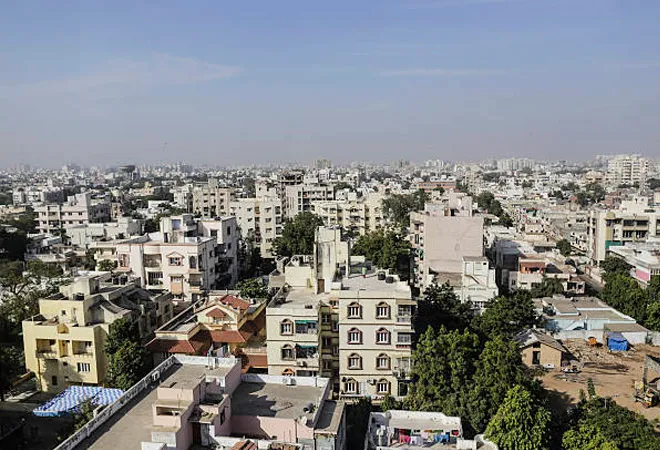-
CENTRES
Progammes & Centres
Location
As urbanisation in India ratchets up, cities would need to be more resilient, both environmentally and economically

City governing institutions in India are under tremendous stress from a large and ever increasing population. This is noted from their performance in regulating various citizen activities and in fulfilling their needs. The demands of a large city population are numerous, and due to various reasons, the institutions are falling behind in meeting their expectations. As a result, chaos and inferior quality of life prevail in most cities.
In this article, two aspects of concern are discussed: The environment and the economy. Indian cities display numerous deficiencies in this regard, which need correction. Accordingly, the article emphasises that proper management of these aspects makes cities liveable. Clean environments ensure good health and preserve biodiversity. Similarly, strong city economies assist in offering an improved quality of life.
For this article, the environment is reviewed on the basis of its various determinants, including air quality, green cover, surface water bodies, drainage, and sanitation. Whereas the economic situation is examined from the city government’s ability to finance its functioning and to create job opportunities for the needy population.
Better management techniques and enforcement of rules are also required in the construction and sanitation sectors.
Managing the environment
To maintain air quality, for example, eco-friendly, affordable, and convenient methods must be made available to people for carrying out activities, and civic agencies should assist people in adopting these methods. Such measures can help in reducing the serious problem of air pollution. This requires a shift to cleaner forms of energy in the transport, industry, and power sectors, all of which are major pollution sources. Better management techniques and enforcement of rules are also required in the construction and sanitation sectors. On the cultural front, the issue of burning firecrackers on certain occasions needs to be resolved through dialogue with communities.
Cities having adequate green cover (trees, plants) are also the ones with low temperatures and better air quality. However, there are growing instances of green cover reduction due to the concretisation (construction of buildings and infrastructure) of cities and the growth of unplanned/unauthorised constructions (houses, shops). The outward spatial expansion of cities has also resulted in reduced farmlands and open spaces. It is necessary to protect existing green cover and expand it in a planned manner as plants help in reducing carbon dioxide and releasing oxygen into the atmosphere. Trees and plants also help in reducing heat generated by various activities and the transport sector.
Surface water bodies such as rivers, lakes, and ponds play an important role in meeting water needs and maintaining the ecosystem and air quality. These need to be protected from the entry of untreated wastewater, industrial effluents, and garbage/debris. Proper monitoring of water bodies, strict action against violators, and helping communities in adopting eco-friendly methods for wastewater/garbage management can be useful steps in controlling the problem.
Based on city-specific waste generation characteristics, the models should be able to address aspects related to waste segregation at source, its reuse, and safe disposal.
Water logging/flooding during the rainy season is quite common and should not be allowed to occur. Besides causing inconvenience to people, the conditions are ideal for the breeding of mosquitoes. Such spots should be identified and improved through urban planning and development interventions. These include addressing drainage deficiencies, drain maintenance, and provision of rainwater harvesting infrastructure. Covering all parts of the city by an underground drainage network that has adequate water-carrying capacity can help in transferring rain/storm water to recycling plants and surface water bodies.
The management of solid waste has become a major issue in cities. Huge quantities of waste are generated, but administrative efficiency in its collection and disposal is usually lacking. Thus, waste deposits along roadsides, in open drains, and on vacant lands are a common sight. At landfill sites (where waste collected from the city is dumped by the municipality), the environmental conditions are the worst. Therefore, civic agencies need to develop and apply sustainable waste management models. Based on city-specific waste generation characteristics, the models should be able to address aspects related to waste segregation at source, its reuse, and safe disposal. The informal waste pickers should be integrated into the collection and segregation process.
Managing economy
In terms of economy, the financial condition of city government determines its ability to perform its duties and implement infrastructure projects proposed in master plans. Generally, fewer funds are available and, thus, deficiencies are common. The condition needs to be improved by strengthening the local government’s resource-raising ability. In addition to the improved collection of municipal taxes and user charges, untapped potential should be explored. Some options include public-private-community partnerships in infrastructure/service delivery, land value capture, and re-densification of land spaces by increasing floor-area ratio (FAR).
Generating awareness among the unemployed about available work opportunities, developing their skills, assisting them in finding work, and creating a wide range of opportunities can help in addressing the issue.
The other important economic aspect is the city’s employment profile. Employment leads to economic growth and development, whereas unemployment not only reduces economic output but also has negative effects on people. Unemployed persons are more likely to indulge in criminal acts. The official statistics for Delhi show an unemployment rate of 6.3 percent in 2020-21; 19 percent of the unemployed were graduates and above. Chandigarh recorded an unemployment rate of 7.5 percent. Generating awareness among the unemployed about available work opportunities, developing their skills, assisting them in finding work, and creating a wide range of opportunities can help in addressing the issue. In particular, the city government needs to pay attention to the issue of unemployment in slums and unauthorised colonies, and the needs of workers engaged in informal economic activities.
Thus, making cities resilient requires maintaining the above-mentioned determinants of the environment and economy in proper order. India is expected to urbanise significantly, and to properly manage the situation, it is necessary to strengthen the abilities of the governing institutions.
Rumi Aijaz is a Senior Fellow at the Observer Research Foundation
The views expressed above belong to the author(s). ORF research and analyses now available on Telegram! Click here to access our curated content — blogs, longforms and interviews.

Rumi Aijaz is Senior Fellow at ORF where he is responsible for the conduct of the Urban Policy Research Initiative. He conceived and designed the ...
Read More +